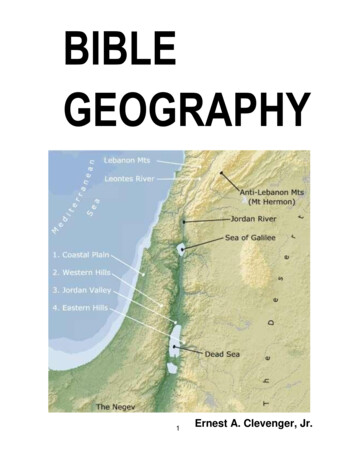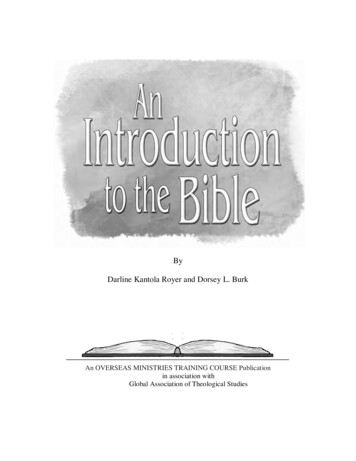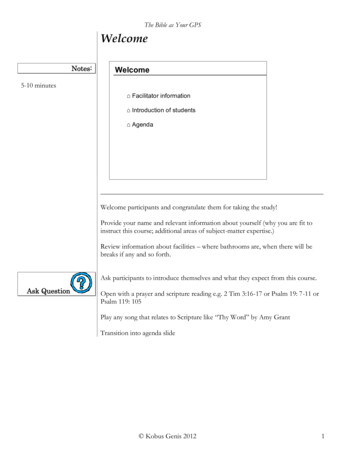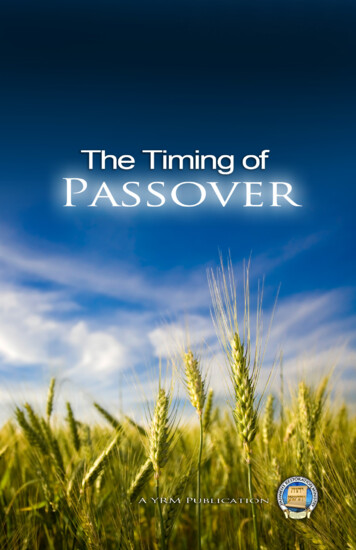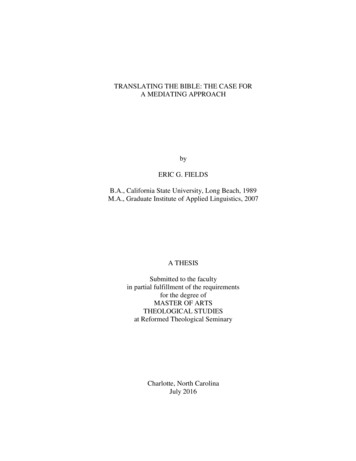
Transcription
TRANSLATING THE BIBLE: THE CASE FORA MEDIATING APPROACHbyERIC G. FIELDSB.A., California State University, Long Beach, 1989M.A., Graduate Institute of Applied Linguistics, 2007A THESISSubmitted to the facultyin partial fulfillment of the requirementsfor the degree ofMASTER OF ARTSTHEOLOGICAL STUDIESat Reformed Theological SeminaryCharlotte, North CarolinaJuly 2016
Accepted:Mark A. HouseSecond Readerii
ABSTRACTTRANSLATING THE BIBLE: THE CASE FORA MEDIATING APPROACHEric G. FieldsMany Evangelical Christians in America tend to prefer more literal approaches toBible translation rather than more idiomatic ones. Their preference for this can be quitestrong at times, with some even viewing those who prefer more idiomatic approaches assimply being in the wrong. In this thesis I seek to demonstrate that there are seriouslimitations to a literal Bible translation strategy and real benefits in recognizing the merits ofa more idiomatic approach. First I examine the biblical teaching and views of importantfigures in church history associated with this issue. Then I show how the various translationapproaches impact theology. Specifically, I argue for the merits of a more literal approach intheological and ecclesiastical contexts. But more importantly, I argue that there are linguisticweaknesses and limitations inherent in using a literal Bible translation strategy even in thetheological realm. Finally, as an alternative, I argue for a mediating position that reflects theimportance of having a more informed understanding of the nature of language, of thecomplex process of Bible translation, and of the various difficulties related to an overlyliteral approach to Bible translation.iii
CONTENTSLIST OF ILLUSTRATIONS . viLIST OF ABBREVIATIONS . viiChapter1. INTRODUCTION . 1Literature Review. 72. BIBLICAL TEACHING . 9Jots and Tittles . 9Prophecy and Tongues . 13Adding To and Taking Away . 173. CHURCH HISTORY. 20Translation in the Ancient World . 21Translation around the Time of the Reformation . 24Translation in Modern Times. 294. THEOLOGY . 34General Theology and the Nature of Language . 34Various Approaches to Bible Translation . 36What are the Merits of a Literal Approach? . 41What are the Limitations to a Literal Approach?. 53Why a Mediating Position? . 74iv
5. CONCLUSION . 77BIBLIOGRAPHY . 80v
LIST OF ILLUSTRATIONSFigurePage1. John Beekman and John Callow, Four Types of Translations fromTranslating the Word of God, with Scripture and Topical Indexes, 1974 .38vi
LIST OF n Standard Version (1901)Contemporary English Version (1995)English Standard Version (2001, 2011)Good News Bible (also TEV) (1976)Holman Christian Standard Bible (2004)King James Version (1611)Living Bible: Paraphrased (1971)Septuagint (Rahlfs 1935, 2006)The Message (2002)New American Standard Bible (1971, 1995)New English Translation (2005)New International Version (1978, 1984, 2011)New International Reader’s Version (1996)New King James Version (1982)New Living Translation (1996, 2004, 2007)New Revised Standard Version (1989)New TestamentOld TestamentThe New Testament in Modern English (1958, 1972)Receptor Language (also Target Language)Revised Standard Version (1952)Revised Version (1881, 1885)Source LanguageToday’s English Version (also GNB) (1976)Today’s New International Version (2005)vii
CHAPTER 1INTRODUCTIONBible translation is a complex process. It involves at least two different languages. Onthe one hand, the source language of the text will be either Old Testament Hebrew, Aramaic,or New Testament Greek. On the other, the receptor language will, for our purposes, beEnglish, although occasional reference will be made to translations into the radicallydifferent, non-Indo-European languages of the world. In translation theory, the biblicallanguages (as well as any other languages that are used as source texts for translation, such asthe Old Testament Greek of the Septuagint or the Latin Vulgate) are called the sourcelanguages, abbreviated SL, and the language into which the text will be translated is calledthe receptor language, or RL.1Why is Bible translation considered a complex process? Isn’t translation concernedwith words and with choosing the best fit for each word? Can’t translators simply look at thewords in the SL, study their various meanings and nuances, and then go looking for the bestmatching words in the RL ad infinitum until the work is done? Why, then, should translationbe viewed as a complex process?The starting point for understanding the complexity and nature of Bible translation isin first recognizing that there are at least two different languages involved in the process.This doesn’t sound like rocket science, but consider this: Each language of the world’s more1John Beekman and John Callow, Translating the Word of God, with Scripture and Topical Indexes(Grand Rapids, MI: Zondervan, 1974), 19-32.1
than 7,000 languages2 is a unique collection of words and arrangements of words, called thelanguage’s lexicon and grammar. These join together in various ways to form a uniquemeans of communication. Because of this, no two languages are exactly alike. Their wordsare different, although there can be borrowed words from other languages that enter in andinfluence the lexicon in various ways. And the ways in which their words join together aredifferent, too, although there are similar ways and patterns of constructing phrases, clauses,sentences, and so on.To repeat, translation is a complex process, and it involves at least two differentlanguages. And each of these languages has its own unique lexicon and grammar that cometogether to form a unique system of communication. That is, the unique words and wordpatterns in a language come together for the purpose of connecting people to one another. ByGod’s grace, humans have been created in the image of God (Gen. 1:26-27), and this means,among other things, that people have a built-in capacity to learn language at a remarkablyearly age and then use it productively throughout life either for good or for evil (Jas. 3:5-12).Because of this, each language is capable of development and change over time to suit thecommunication needs of mankind. No two languages are exactly alike, and no languageremains static, either. The languages of the world are in a state of constant flux, with theaddition of words and the shifting of word meanings in everyday use. This is part of thenature of language as it functions a means of human communication.Again, Bible translation is a complex process because it involves at least two differentlanguages. Language is used in human communication. The lexicons and grammars of eachlanguage are vehicles used for conveying thought and serving the purpose of human2SIL International Publications, “Ethnologue: Languages of the World.”https://www.ethnologue.com/statistics (accessed July 14, 2016). The Ethnologue currently lists 7,097 livinglanguages in the world today.2
communication. Saying that languages have a lexicon and a grammar, though, only scratchesthe surface. Linguists recognize that languages operate on many different levelssimultaneously.3 On the lower levels of language, sounds come together in various ways andpatterns to form syllables and morphemes, the smallest meaningful units of words. On themiddle levels, these building blocks combine to form words with many different functionsand purposes. Words can be categorized based on their grammatical part of speech, a moretraditional linguistic category that includes nouns, pronouns, verbs, adjectives, adverbs, andthe like. Or, words can be grouped by their underlying semantic class, whether they are“noun-like” objects or “verb-like” events, whether they are abstract words that modify otherwords or relational words that group and link other words together. In other words, not allwords are created equal, and this goes for their content and function. On the higher levels,these different categories of words are arranged in recognizable phrase patterns, clauses, andsentences. And these, too, join together to combine in unique and meaningful ways. Wordorder is never random; it is always motivated by the speaker’s intention in communication ashe or she uses and flaunts the known conventions of the particular language in question. Andsentences combine to form paragraphs and discourses, the highest linguistic levels yet. Ofcourse, these various linguistic levels don’t even touch upon the pragmatic function oflanguage, including how implicit and explicit information is used with respect to contextualand background considerations, nor the cultural, social, historical, or religious factors thatalso greatly influence the complexity involved in translation.Although languages are much more than a collection of words (i.e., their lexicon), thewords we use are critical. Specifically, the words of a language are unique in their meanings,3Talmy Givón, Syntax: A Functional-Typological Introduction (Amsterdam: J. Benjamins, 1984), 30-33.3
semantic ranges, and functions.4 To begin, words usually have a primary meaning. This iswhat a person thinks of first when a word comes to them in isolation, context excluded. Butwords can have more than one meaning or sense, and usually do. This is polysemy, thecapacity of a single word to have multiple senses. Putting these various meanings togethermakes up a word’s semantic range. No one ever uses a word’s full semantic range at a givenpoint in time. Rather, a single, specific sense is usually intended for each use of the word inits context.Additionally, a word’s function refers to how it is used in relation to other words of alanguage. Words have natural allies, or other words that mean and function much like theydo. They also have opposites of various kinds that can mean something much different. Eachword also has a denotation, or a real-world referent it is pointing to, and a connotation, or thenuance that word has for a select group of people. These various properties of words areespecially challenging in translation, because they don’t all carry across into other languagesin the same ways. There are many things to consider when thinking of words in translation.The speakers of a language use this knowledge of words and word patterns intuitively tocreate a unique form of communication. Knowing how the language really works andfunctions, then, is an essential piece of understanding why Bible translation is a complexprocess.Remember the theme of this thesis: Bible translation is a complex process thatinvolves at least two different languages. At times in the process, words won’t match up sowell between source and receptor languages. That’s an understatement, and it’s the nature of4Gordon Fee and Mark Strauss, How to Choose a Translation for All Its Worth: A Guide toUnderstanding and Using Bible Versions (Grand Rapids, MI: Zondervan, 2007), 45-60.4
the beast. Paraphrase is the attempt to say something equivalent using different words.5 Thisis not an option in translation, but a necessity. But what are the proper limits of paraphrase?Should it be appealed to first and right away? Or, only as a last resort? How can it be usedeffectively without fear of misrepresenting the source text? Skilled speakers of a languageknow how to summarize or paraphrase a complex idea, making it relevant to their hearingaudience. But more is involved when paraphrase is used in translation. It is the art of properlysaying something equivalent while using different words when there isn’t an exact match ofwords and word properties across languages. Paraphrase is unavoidable as the Bible istranslated into English, and even more so when translated into the non-Indo-Europeanlanguages of the world that do not benefit from having a prolonged history with the Bible oreven a shared cultural or historical background with the biblical world.Another factor that makes the translation process difficult is understanding thesignificance of word order. Speakers use various word order combinations to structure whatthey are saying, to communicate more effectively with others, and to highlight what they arethinking.6 Word order is never random, but rather, it is chosen with very specific intentions inmind. Because of this, each language has its own ways of structuring information. The rulesfor how word order works and affects meaning need to be understood in both source andreceptor languages alike. Misuse of word order in the RL can result in stylistically poorgrammar, lack of meaning, or even wrong meaning and emphasis.Linguistics is the science of language. Not everyone is a linguist or wants to become alinguist, but everyone uses language and has an opinion on how they think it works, whether5Anna Wierzbicka, Semantics, Culture, and Cognition: Universal Human Concepts in Culture-specificConfigurations (Oxford: Oxford University Press, 1992), 3-27.6Stephen Levinsohn, Discourse Features of New Testament Greek: A Coursebook on the InformationStructure of New Testament Greek (Dallas, TX: SIL International, 2000), vii-x, 1-70.5
their opinion is correct or incorrect. Since Bible translation is a complex process, it isimportant to understand and to contemplate how unique and complex languages really are.The SL and RL are sometimes radically divergent in a myriad of ways. Because eachlanguage has a unique lexicon and grammar, and these come together to form unique patternsof communication, it is important to consider, then, in what ways each language should beallowed to contribute to the translation process.For instance, should the SL (in our case the biblical languages of Hebrew, Aramaic,and Greek) contribute both its lexical word meanings and its grammatical forms to thetranslation process? If so, how should the RL receive them? Should the formal patterns usedin the SL determine what grammatical forms are used in the RL, even if it requires that anative speaker of the RL has to think using the patterns of the other language that is not his orher own? This would favor the SL too much. Or, should the lexicon and grammar of the RLbe used in clear, natural, and recognizable ways for the benefit of the hearers of thatlanguage? And could this favor the RL too much? What are the limits? And abuses?These are not simple questions to answer. Form, meaning, and context are theinterrelated foundations of language. Nothing can be understood meaningfully in languagewithout some kind of form and context. Because of this, some believe that to divorcemeaning from form in translation leads to distortion. And yet, as expressed above, eachlanguage has its own ways of forming and arranging words together in meaningful patterns.To disregard this in the RL, causing the hearers to have to think according to the grammaticalforms and word patterns found in the SL, may lead to an even worse kind of distortion.Many Evangelical Christians in America tend to prefer more literal approaches toBible translation rather than more idiomatic ones. Their preference for this can be quite6
strong at times, with some even viewing those who prefer more idiomatic approaches assimply being in the wrong. Yet there are serious limitations to a literal Bible translationstrategy and real benefits in recognizing the merits of a more idiomatic approach. In chapters2 and 3, I will examine the biblical teaching and relevant discussions in church historyassociated with this issue. Then, in chapter 4, I will show how the various translationapproaches impact theology. Specifically, I will argue for the merits of a more literalapproach in theological and ecclesiastical contexts. But more importantly, I will argue thatthere are linguistic weaknesses and limitations inherent in using a literal Bible translationstrategy even in the theological realm. Finally, as an alternative, I will argue for a mediatingposition that reflects the importance of having a more informed understanding of the natureof language, of the complex process of Bible translation, and of the various difficultiesrelated to an overly literal approach to Bible translation.Literature ReviewStudying the various approaches to Bible translation can be a very personal matter.For this reason, this thesis will first establish a theoretical foundation for viewing the variousapproaches to translation by using Beekman’s and Callow’s standard, classic work on thesubject, Translating the Word of God, with Scripture and Topical Indexes, 1974. Thearguments for a more literal approach to translation will be taken from Leland Ryken’sUnderstanding English Bible Translation: A Case for an Essentially Literal Approach, 2009,where dialogue concerning the pros and cons of his arguments will also be given. Thearguments against a more literal approach will be made from various linguistic resourcesconcerning the nature of language, including the Beekman and Callow book mentioned7
above, from Anna Wierzbicka’s Semantics, Culture, and Cognition: Universal HumanConcepts in Culture-specific Configurations, 1992, and from Stephen Levinsohn’s DiscourseFeatures of New Testament Greek: A Coursebook on Information Structure of NewTestament Greek, 2000, as well as examples from Fee’s and Strauss’s How to Choose aTranslation for All Its Worth: A Guide to Understanding and Using Bible Versions, 2007,and articles by D. A. Carson, found in Scorgie, Strauss, and Voth, 2003, and by MarkStrauss, 2005. These resources will provide the necessary evidence for gaining a betterunderstanding of the nature of language and its importance, especially as it relates to thecomplex process of Bible translation.8
CHAPTER 2BIBLICAL TEACHINGWhat does the Bible have to say about the complex process of Bible translation?There really aren’t any whole passages that speak directly to this issue, but there are a fewthoughts that can be gleaned from the Scriptures and productively applied to this situation.The passage where Jesus speaks about “jots and tittles,” the passage where Paul speaks about“prophecy and tongues,” and the passage where John writes about “adding to and takingaway from Scriptures” all point to important thoughts concerning our understanding of thenature of language and the complex process of Bible translation.Jots and TittlesFirst consider the “jots and tittles” passage found at Matthew 5:17-20. The ESVtranslates these words “iota” and “dot,” respectively.1 To begin, this passage is found withinthe lengthy Sermon on the Mount discourse, which runs from Matthew 5:1 to 7:29. Generallyspeaking, Jesus is establishing something like a “Christian constitution” for his discipleshere. That is, he is stating the principles by which a member of the kingdom of heavenshould live. Are these principles the same as those found in the Old Testament, which Jesusis using in new ways? Or, are they really novel concepts for his disciples? To put it anotherway, can one assume there is some degree of continuity or discontinuity in going from the1Unless otherwise indicated, all Scripture quotations in this thesis are from The Holy Bible, EnglishStandard Version (ESV), copyright 2001 by Crossway, a publishing ministry of Good News Publishers.9
old covenant teachings to the new? Let’s keep this question in mind as we look at Jesus’words in this passage:17Do not think that I have come to abolish the Law or the Prophets; I have not cometo abolish them but to fulfill them. 18For truly, I say to you, until heaven and earthpass away, not an iota, not a dot, will pass from the Law until all is accomplished.19Therefore whoever relaxes one of the least of these commandments and teachesothers to do the same will be called least in the kingdom of heaven, but whoever doesthem and teaches them will be called great in the kingdom of heaven. 20For I tell you,unless your righteousness exceeds that of the scribes and Pharisees, you will neverenter the kingdom of heaven.I think it is safe to say that Jesus is in some way upholding the importance of the OldTestament teaching here as it is represented by his use of the noun phrase, “the Law and theProphets.” Specifically, in verse 17 he states that he has “not come to abolish them, but tofulfill them.” Abolishing them would imply Jesus saw a discontinuity or break between theOld Testament teaching and his own, but fulfilling them implies he envisions a continuity ofsome kind. That is to say, Jesus is tying his ministry goals to doing, accomplishing, andfulfilling that which has already been written about him in the past. We also have arestatement of this same idea of continuity in verse 18, but using more colorful, emphaticlanguage: “For truly, I say to you, until heaven and earth pass away, not an iota, not a dot,will pass from the Law until all is accomplished.”What is an “iota” and a “dot”? Or, a “jot and tittle” as the NKJV has it? In Greek, thewords are ἰῶτα (iōta) and κεραία (keraia), respectively. According to the Wilbur Gingrichand Frederick Danker lexicon, the ἰῶτα is “the smallest letter of the Greek alphabet,”2 whilethe κεραία is a “projection, hook as part of a letter.”3 In this expression, then, Jesus seemsinterested in saying that, at the very least, the writings found in the Old Testament Scriptures2“ἰῶτα,” in Wilbur Gingrich and Frederick Danker, Shorter Lexicon of the Greek New Testament(Chicago: University of Chicago Press, 1965), 96.3Ibid., 108; “κεραία.”10
are still important under the new covenant, so much so that the very smallest marking ordetail shouldn’t be overlooked.However, R. T. France says that if Jesus intends his disciples “to continue to obey allthe commandments of the Torah . . . more meticulously than those Jews who had notfollowed Jesus,” then Matthew’s portrayal of Jesus is “out of step with the overall thrust ofNT Christianity,” it is out of step with “the ceremonial aspects of the OT law, particularly itssacrificial provisions,” out of step with the letter to the Hebrews, and out of step with Paul’sattitude of “freedom from the law.”4 In other words, according to France, there appears to bea strong discontinuity with respect to the Law and the Prophets in Jesus’ teaching, too. Thatis to say, along with the continuity of Jesus upholding the Law and the Prophets as statedabove, there also appears to be a strong discontinuity with respect to those aspects of the OTLaw and Prophets that are uniquely fulfilled in and by him and that are not to be furtherapplied to his disciples, at least not directly.Consider an application of this passage to the complex process of Bible translation. Ifthe Scriptures in the original languages are written using markings called “jots and tittles,”then what does that mean for the translator of the Scriptures into other languages? Jesus saysthese markings are still important and relevant to his disciples in that he hasn’t come toabolish them, but to fulfill them. They can’t be overlooked. But if the receptor language orRL doesn’t have “jots and tittles,” what is one to make of it? Is the translator required to finda way to incorporate the “jots and tittles” into the RL, foreign as they may be?As has been established up to this point, Bible translation is a complex process thatinvolves at least two different languages. In this example, the translator should determine4Richard France, The Gospel of Matthew, vol. 1, The New International Commentary on the NewTestament (Grand Rapids, MI: Eerdmans, 2007), 177-191.11
what meaningful function “jots and tittles” have in the Law and the Prophets, or the SL text,and then translate their significance into the RL. To balance the dynamics of continuity anddiscontinuity, the translator should maintain the meaning or significance of the SL “jots andtittles,” so as to not overlook the importance of them, but then let go of the actual or formal“jot and tittle” marking itself, since that would have no meaning for a reader or hearer in theRL language.To press this odd example a little further, one could ask, doesn’t Jesus mean what hesays? He has said that “jots and tittles” are important, and he also says that the least of thesethings written in the Law will not pass away until all has been accomplished. Certainly Jesusmeans what he says, but his meaning specifically refers to the preservation of certain formsfound in the original languages. Thus the literal preservation of “jots and tittles” intranslations is the wrong conclusion to draw. Jesus’ clear meaning is that attention should begiven to even the smallest details of the holy writings of God as originally given. Thispristine form is what should be preserved and not overlooked in translation.For example, consider Matthew 5:18, where Jesus says, “until heaven and earth passaway, not an iota, not a dot, will pass from the Law. . . .” In Greek, the verb form παρέλθῃ(parelthē) is used twice here, which is translated as “pass away” and “will pass,”respectively. In both cases, it is a third person, aorist subjunctive verb form, recognizable bythe iota subscript found underneath the final letter. What a small marking! In looking atvarious English versions of this word in its first instance, translators consistently use atemporal “until” clause with the English indicative verbs “pass away” (ESV, NASB, NKJV)and “disappear” (NIV, NLT), which are common translation strategies for this temporalGreek construction. For the second instance, indicative translations such as “will pass” (ESV,12
NKJV), “shall pass” (NASB), and “will disappear” (NIV, NLT) are also common strategiesfor rendering this emphatic Greek construction. But the point is this: None of our Englishtranslations sees the need to retain a formal “iota” here. Translators regard equivalentconstructions as sufficient for communicating what Jesus is quoted as having said.5 Themeaning attached to the iota subscript has been retained using equivalent constructions in theRL, while the formal use of it has been let go, given that this is not a formal convention usedin the English language.Jesus’ use of the “jots and tittles,” then, serves to protect the complete contents of theoriginal form of the Law and the Prophets. That is, it is not a prescriptive statement againstthe loss of formal attributes of the original text, but rather, that the hearer and translator alikewould be sure to consider and include all the relevant components of meaning in theirinterpretation of the original biblical texts. In translation, this would ensure that the completemessage would be communicated to all audiences, without loss of meaning, even if theformal “jots and tittles” were not retained in the RL.Prophecy and TonguesNext, consider the passage on prophecy and tongues found at 1 Corinthians 14:1-13.Following on the heels of the great “love chapter,” Paul continues his discussion of spiritualgifts from chapter twelve, making a specific comparison between speaking in tongues andprophesying:1Pursue love, and earnestly desire the spiritual gifts, especially that you mayprophesy. 2For one who speaks in a tongue speaks not to men but to God; for no oneunderstands him, but he utters mysteries in the Spirit. 3On the other hand, the one whoprophesies speaks to people for their upbuilding and encouragement and consolation.4The one who speaks in a tongue builds up himself, but the one who prophesies builds5Jesus’ native language was likely Aramaic.13
up the church. 5Now I want you all to speak in tongues, but even more to prophesy.The one who prophesies is greater than the one who speaks in tongues, unlesssomeone interprets, so that the church may be built up.6Now, brothers, if I come to you speaking in tongues, how will I benefit youunless I bring you some revelation or knowledge or prophecy or teaching? 7If evenlifeless instruments, such as the flute or the harp, do not give distinct notes, how willanyone know what is played? 8And if the bugle gives an indistinct sound, who willget ready for battle? 9So with yourselves, if with your tongue you utter speech that isnot intelligible, how will anyone know what is said? For you will be speaking into theair. 10There are doubtless many different languages in the world, and none is withoutmeaning, 11but if I do not know the mean
TRANSLATING THE BIBLE: THE CASE FOR A MEDIATING APPROACH by ERIC G. FIELDS B.A., California State University, Long Beach, 1989 . (Grand Rapids, MI: Zondervan, 1974), 19-32. 2 than 7,000 languages2 is a unique collection of words and arrangements of words, called the



